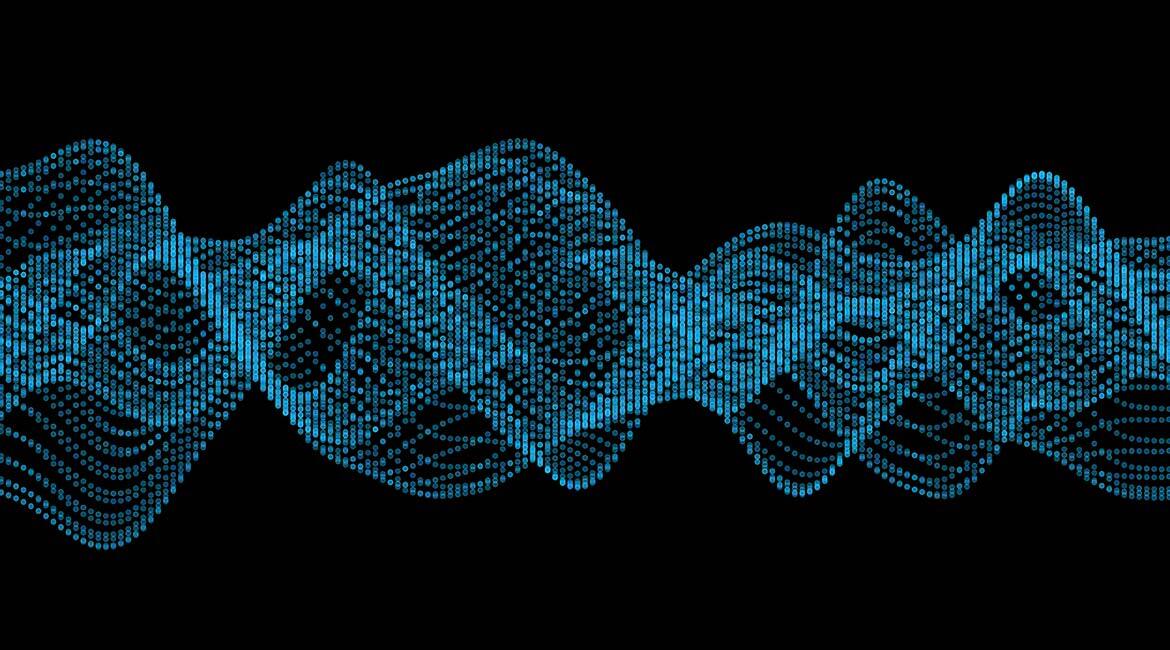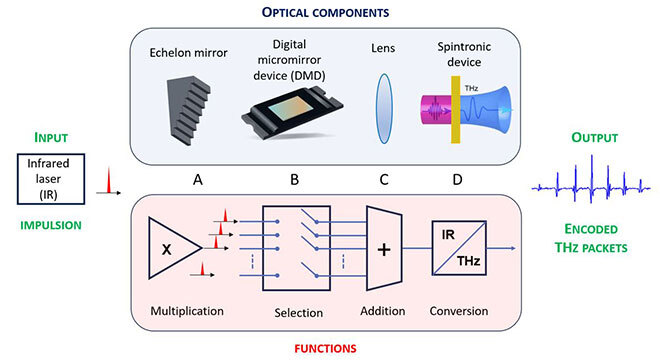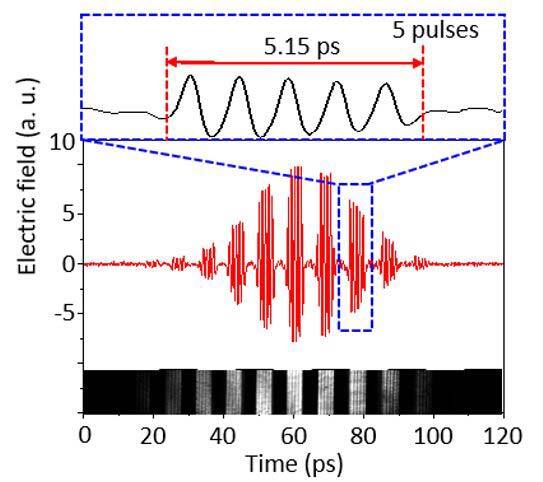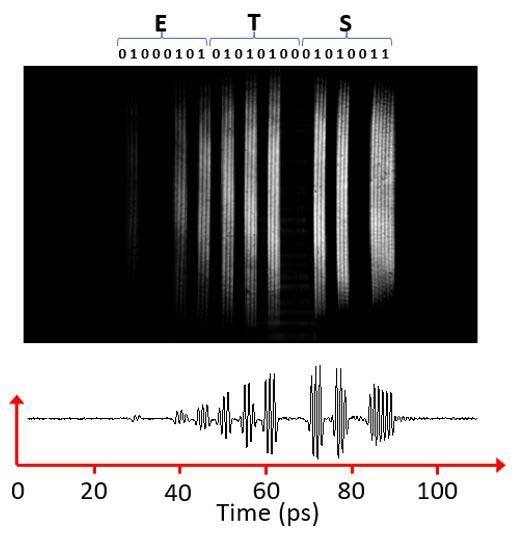Terahertz (THz) Communication by Packets

Purchased on Gettyimages. Copyright.
In this study, we present a new technique for parallel generation and encoding of an electromagnetic wave pulse train in terahertz (THz) frequencies. The method we propose combines ultrafast optics and signal processing techniques to generate an accurate series of synchronized pulses. The innovation of this demonstration lies in its ability to encode information in THz frequencies in an ultrafast manner, without requiring high-speed electronics, but rather by using a concept from geometric optics. Our results open up new avenues of research for future communication systems based on THz wave packets.
The Unexplored Potential of Terahertz in Communication
In an ever-changing world, the race to develop faster, more efficient, and safer methods of communication is relentless. To meet this demand, the latest electromagnetic frontier to be conquered is the field of terahertz (THz) frequencies. These frequencies have the potential to increase the capacity of today’s communication networks tenfold. To visualize the capacities involved, imagine your current Wi-Fi network as a 1 cm diameter water pipe, whereas a THz network is 30 cm in diameter. It’s easy to figure out which pipe will allow a greater flow of water. This analogy refers to the frequencies in question: THz waves are in the 300 GHz up to 10 THz bandwidth, or, in other words, they are essentially 1000x faster than the frequencies used by cell phones! This characteristic brings many benefits to these waves, including:
- Ultrafast data transfer capabilities that allow downloading an HD movie or streaming 4K videos in a matter of seconds. It’s like switching from a bicycle to a high-speed train to get where you want to go!
- A wide frequency bandwidth that allows simultaneous connection with no slowdown and for a larger number of devices. It’s like having a multi-lane highway capable of accommodating hundreds of cars (devices) without traffic jams.
Despite the many expected benefits and discussions—on their use in communication systems since the 1970s, the solution for a THz communication system is far from simple or unique. Among the avenues being considered is an approach overlooked in the THz field but extremely well established in microwave or RF communications: packet communication. However, electronic modulators that can generate this type of modulated wave at THz frequencies do not yet exist. This is where our research at ÉTS begins, namely to find a simple way of modulating THz wave packets with sub-picosecond (< 1×10-12 second) time resolution.
Terahertz Wave Packet Modulation Technique
This technique is broken down into four steps, as shown in Figure 1.

Figure 1: Diagram of the experimental set-up used.
Multiplication: A near-infrared (IR) optical pulse is multiplied using a step-shaped mirror called an echelon mirror. After being reflected by it, the laser pulse is split into several pulses. The pulses are then separated in time in by a round trip travel time at the light speed of 1 ps, corresponding to the spacing between the steps of the echelon mirror. These pulses are also separated in space, also according to the spacing between the steps.
Selection: This step is responsible for determining if an optical pulse passes or not from the optical pulse packet generated in (A). Thanks to the formation of an optical pulse train where each pulse is separated in space, we have access to redirect light individually using a matrix of controllable micromirrors (DMD)—this is the same matrix used in video projectors. By displaying masks on the DMD, we can modulate—with a resolution of 1 ps or less—the optical pulse train. An example of a modulation mask is shown in Figure 2.
Addition: Management in time of optical pulses has been adjusted in step (B); however, the pulses remain separated in space. Using a simple optical lens, we aim these pulses at a single point, on the IR/THz converter. Following the rules of geometric optics, the pulse train passes through the focal point in single file, achieving a parallel-to-series conversion.
Conversion: The THz generation method is based on a spintronic device involving a process known as the “inverse spin Hall effect,” in which a femtosecond laser pulse converts its energy into THz radiation. Thus, each optical pulse in the packet generates a THz pulse, generating the coded THz pulse packet.

Figure 2: Controlling the number of pulses as a function of the mask applied to the DMD. Generation of 5-pulse packets.
Importance of the Technique and Future Challenges
Thanks to the DMD’s ability to encode each THz pulse individually, we were able to view the generation of 3 pulses as 1 bit. This allows the use of an ASCII binary protocol, an “on-off keying” (OOK) modulation to generate the three “ETS” letters of the university (see Figure 3). The corresponding bit pattern is 01000101 01010100 01010011. This modulation technique allowed us to accurately convert the information in space of the optical beam into the information in time of a pulse train at a carrier frequency of 1 THz.
With a one-pulse-per-bit protocol, and given the number of pulses generated—128 pulses, the number of steps in our echelon mirror—with modulation rates of 6 kHz (DMD refresh rate), our system can encode information at speeds of 768 kb/s. This data transfer rate can be increased by multiplexing several laser pulses on the DMD’s second dimension or by replacing it with a faster electro-optic modulator. Ultimately, the modulation of each pulse in our laser system—at a repetition rate of 80 MHz—could generate up to 80 million packets, each with 128 modulated pulses, enabling data transfers at speeds of 10 Gb/s. However, this level of transfer remains to be demonstrated. Real-time detection of these ultrafast pulse packets is our next challenge… Good news for future students!

Figure 3: Spatial encoding of the THz pulse train forming the letters “ETS” in binary format.
Benefits for Many Sectors
THz communication is key to the future of short-range wireless technologies. From latency-free augmented reality to near-instantaneous sharing of large files, it paves the way for a connected world beyond our current imagination. It’s the next stage in our digital evolution, where everything happens at near-thought speeds. As with any emerging technology, security and privacy concerns remain paramount.
In photonics, one of the approaches being considered to solve the challenges of ultrafast information detection and security simultaneously is the use of quantum sensors. This prospect signals many years of exciting exploration! Fortunately, such anticipated advances will not be limited to faster downloads alone but will transform a variety of sectors, including healthcare (ultrafast medical imaging), security (high-resolution scanning), and manufacturing (high-precision automation). This is equivalent to equipping industries with a technological superhero capable of solving problems faster and with greater accuracy.
Additional Information
For more information on this research, please refer to the following paper online:
Nkeck, J. E., Béliveau, L. P., Ropagnol, X., Deslandes, D., Morris, D., & Blanchard, F. (2022). Parallel generation and coding of a terahertz pulse train. APL Photonics, 7(12).



